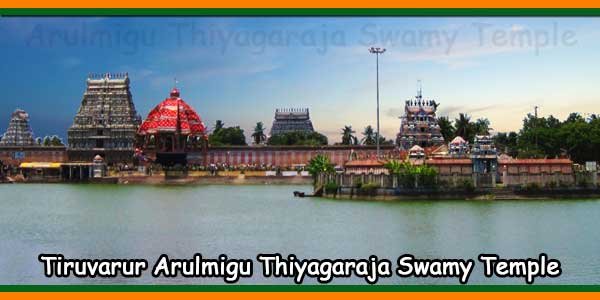Tiruvarur Arulmigu Thiyagaraja Swamy Temple Hours<:
Morning: 5.00 AM to 12.00 Noon
Evening: 4.00 PM to 9.00 PM
In Carnatic music, Syama Sastri, Thiyagaraja and Muthusamy Deetchidar are known as music Trinities.
Syama Sastri (A. D 1762 – 1827):
Syama Sastri excelled in composing songs in Anandha Bairavi ragam. Rare ragas like Chinthamani, Manjee are identified in his some of 300 Kiruthis (a musical form of short lyrics with excellent ornamentation). “Viloma Sappu” a kind of tala, was introduced by him. All his songs are in Sanskrit and Telugu.
SYAMA SASTRI was born to Visvanatha Iyer and Vengalakshmi on April 26, 1762. He was a Tamil – speaking brahmin known as auttara vadama. Visvanatha Iyer and his forefathers were archakas in the temple of Goddess Bangaru Kamakshi.
Syama Sastri’s actual name was Venkata Subrahmanya. But he was affectionately called Syama Sastri. At the age of seven, his Upanayanam was performed. He was taught devotional songs, given sound education in Sanskrit and Telugu. He used to accompany his father to the temple. Gradually his faith in the Goddess grew. Finding his aptitude for music, his mother requested her cousins to teach him the fundamentals of music. Within a short period, the boy became proficient in it.
When Syama Sastri was 18, his father settled down at Thanjavur. A sanyasi, Sangita Svami, an Andhra brahmin, came to their house from Banares. He was pleased with the talents of Syama Sastri and offered to be his guru. After teaching him the mysteries underlying the raga and tala prastaras, he directed Syama Sastri to go to Paccimiriyam Adiyappayya.
Once, Kesavayya, a great musician from Bobbili, came to Thanjavur and challenged the court musicians in handling intricate talas. Syama Sastri had to face him. He entered the temple and stood in deep meditation.
He sang “Devi brova samayamide’ meaning “Devi! now it is the time for you to protect me”. Later he gained confidence and went to the court to face the contest and defeated the challenger.
Muthuuswami Dikshitar and Syama Sastri were good friends. They often met and spent hours together singing. Syama Sastri had deep regard for Thiyagaraja.
Once Syama Sastri was singing Brhadamba in Pudukottai, an elderly saint was pleased and directed him to go to Madurai and sing in praise of Meenaksi Amman and receive her blessings. Syama Sastri decided to do so and composed “navaratnamalika’ (nine kritis)

Thiyagaraja (A.D 1767-1847):
Standardization of Sangathis (singing a lyrical structure in different styles) in kirthanas is reported to be his main contribution. Incorporation of folk and western into karnatic is a notable contribution as revealed by one of his biographers. His “Pancharathna Kirthana” (song consisting of 5 Ragas) is a great masterpiece. Rare ragas like “Navarasa Kanada”,”Vijaya Shree” and “Bhahudari” were brilliantly handled by him.
The life and work of Tyagaraja, the bard of Tiruvayyaru, is a miracle of miracles.
The life and work of Tyagaraja, the bard of Tiruvayyaru, is a miracle of miracles. For no musician, with exception of Purandaradasa, revolutionized and gave direction to Indian music as he did. So creative a musician and saint was he that he has come to be known as Sri Tyaga Brahmam, which is a reference not only to his creativity but carries with it a part of his father’s name, Ramabrahmam.
The bulwark of a great culture, the Vijayanagara Empire, with all its glory, fell at the end of the 16th century. The invasion from the North brought in its wake new, though not always commendable, trends in living. Quite a few Hindu families had to flee to Southern areas which were still peaceful.
Many found shelter under the benign rule of the Nayakas and the Maratha kings of Tamilnadu. Particularly, a number of Telugu families went South and formed nuclei of art and culture and Tyagaraja’s ancestors belonged to one such stock, as he describes himself as descending from the Kakarla family (Kakarla is a village in the Kurnool District of Andhra).
Tiruvarur in the Tanjavur district of South India is a small hamlet; it is small in size, but has great sanctity hallowed by the memory of the three composers, the Trimoorty, of Karnatak music.
Muthusamy Deekshidar (A.D 1776-1835):
He followed his own unique 72 melakartha system, and composed his kirthana in 35 Tala system. He is famous for his social kirthanas. He introduced new rich aesthetic components into Carnatic music. His compositions were in Telugu, Sanskrit and Tamil.
Dikshitar’s songs bring in a mood of meditative devotion of sublime nature which transcends words and feelings.
Dikshitar was probably the most complete classical composer and one of the most versatile men world has ever seen.
Arulmigu Thiyagaraja Swamy Temple Address:
The Executive Officer
Arulmigu ThiyagarajaSwamy Temple,
Thiruvarur – 610001,
Tamilnadu.
Phone : 04366-242343
